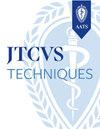Open ascending aorta replacement combined with fenestrated total aortic arch stenting
IF 1.7
Q3 CARDIAC & CARDIOVASCULAR SYSTEMS
引用次数: 0
Abstract
Objective
The aim of this retrospective single-center study was to report a novel hybrid technique of replacement of the ascending aorta and implantation of fenestrated stent-graft of the entire aortic arch for Stanford type A aortic dissection and to analyze clinical experience and outcomes.
Methods
From January 2019 to January 2023 in Tongji hospital, 31 cases (26 men and 5 women, mean age 56.06 ± 10.34 years) with Stanford type A aortic dissection underwent open ascending aorta replacement combined with total endovascular arch repair. All patients underwent ascending aorta replacement without hypothermia or circulatory arrest. Arch intervention was performed with self-modified stent-grafts to preserve the aortic arch native branches.
Result
The surgical technical success rate was 100% in all patients. One (3.22%) patient died after surgery due to cerebral hemorrhage. Five (16.13%) patients with preoperative renal insufficiency required hemodialysis. Six (19.36%) patients were on mechanical ventilation for more than 48 hours. One patient was found to have an endoleak (Type IV). There were 25 (83.33%) patients who underwent follow-up with a median follow-up time of 14.00 months (range, 6.50-28.50 months). Two (8.00%) of them died (1 of infectious shock and the other of respiratory arrest) and 2 (8.00%) underwent aortic reoperation.
Conclusions
Single-stage open ascending aortic replacement combined with the total aortic endovascular arch intervention may provide satisfactory early outcomes in Stanford type A aortic dissection. This strategy may be valuable for a subgroup of patients deemed inappropriate candidates for open classic full arch repair.
开放升主动脉置换术联合开窗全主动脉弓支架植入术
目的回顾单中心研究升主动脉置换与全主动脉弓开窗支架植入术治疗Stanford a型主动脉夹层的新方法,并分析其临床经验和疗效。方法2019年1月~ 2023年1月在同济医院对31例Stanford A型主动脉夹层患者(男26例,女5例,平均年龄56.06±10.34岁)行开放性升主动脉置换术联合全血管内弓修复术。所有患者均行升主动脉置换术,无低温或循环骤停。采用自体改良支架移植术对主动脉弓进行干预,以保留主动脉弓原有分支。结果所有患者手术技术成功率均为100%。1例(3.22%)患者术后因脑出血死亡。术前肾功能不全患者需用血液透析5例(16.13%)。6例(19.36%)患者机械通气时间超过48小时。1例患者发现有内漏(IV型)。随访25例(83.33%),中位随访时间14.00个月(范围6.50 ~ 28.50个月)。其中2例(8.00%)死亡(感染性休克1例,呼吸骤停1例),2例(8.00%)再次行主动脉手术。结论单期开放性升主动脉置换术联合全主动脉弓介入治疗Stanford A型主动脉夹层早期疗效满意。这一策略对于那些被认为不适合进行开放式经典全弓修复的患者可能是有价值的。
本文章由计算机程序翻译,如有差异,请以英文原文为准。
求助全文
约1分钟内获得全文
求助全文

 求助内容:
求助内容: 应助结果提醒方式:
应助结果提醒方式:


